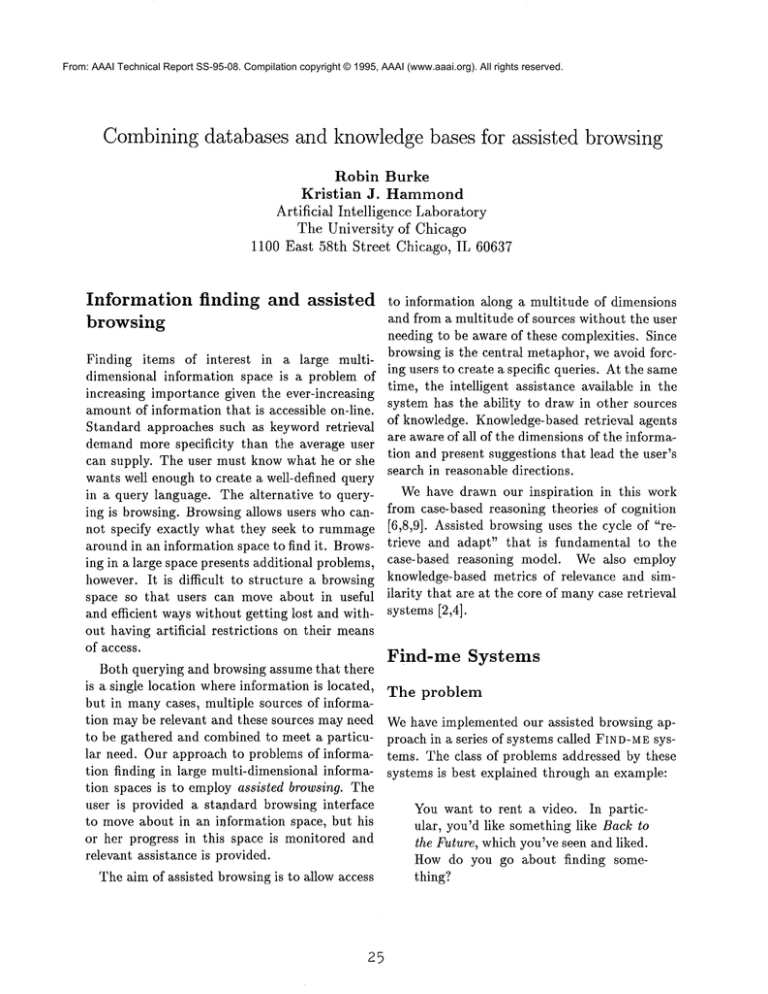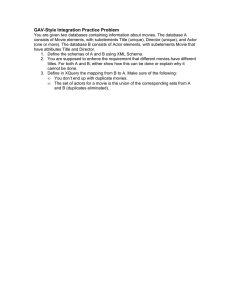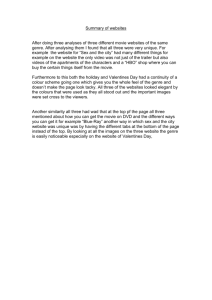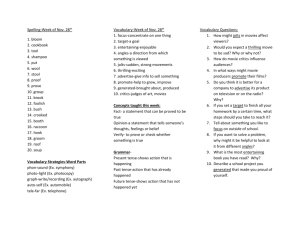Document 13779452
advertisement

From: AAAI Technical Report SS-95-08. Compilation copyright © 1995, AAAI (www.aaai.org). All rights reserved. Combining databases and knowledge bases for assisted browsing Robin Burke Kristian J. Hammond Artificial Intelligence Laboratory The University of Chicago 1100 East 58th Street Chicago, IL 60637 Information finding and assisted browsing Finding items of interest in a large multidimensional information space is a problem of increasing importance given the ever-increasing amountof information that is accessible on-line. Standard approaches such as keyword retrieval demand more specificity than the average user can supply. The user must know what he or she wants well enough to create a well-defined query in a query language. The alternative to querying is browsing. Browsing allows users who cannot specify exactly what they seek to rummage around in an information space to find it. Browsing in a large space presents additional problems, however. It is difficult to structure a browsing space so that users can move about in useful and efficient ways without getting lost and without having artificial restrictions on their means of access. Both querying and browsing assume that there is a single location where information is located, but in manycases, multiple sources of information may be relevant and these sources may need to be gathered and combined to meet a particular need. Our approach to problems of information finding in large multi-dimensional information spaces is to employ assisted browsing. The user is provided a standard browsing interface to move about in an information space, but his or her progress in this space is monitored and relevant assistance is provided. The aim of assisted browsingis to allow access 25 to information along a multitude of dimensions and from a multitude of sources without the user needing to be aware of these complexities. Since browsing is the central metaphor, we avoid forcing users to create a specific queries. At the same time, the intelligent assistance available in the system has the ability to draw in other sources of knowledge. Knowledge-based retrieval agents are aware of all of the dimensionsof the information and present suggestions that lead the user’s search in reasonable directions. We have drawn our inspiration in this work from case-based reasoning theories of cognition [6,8,9]. Assisted browsing uses the cycle of "retrieve and adapt" that is fundamental to the case-based reasoning model. We also employ knowledge-based metrics of relevance and similarity that are at the core of manycase retrieval systems [2,4]. Find-me Systems The problem Wehave implemented our assisted browsing approach in a series of systems called FIND-ME systems. The class of problems addressed by these systems is best explained through an example: You want to rent a video. In particular, you’d like something like Back to the Future, which you’ve seen and liked. How do you go about finding something? Do you want to see the sequel, Back to the Future I17. Do you want to see another Michael J. Fox movie? Do you want to see Crocodile Dundee, another movie about a person dropped into an unfamiliar setting? Time After Time, another time travel film? Who Framed Roger Rabbit?, another movie by the same director? important difference that users see an explicit explanation of why each example was retrieved and can critique particular componentsof that explanation. In most relevance feedback approaches, the user selects some retrieved documents as being more relevant than others, but does not have any detailed feedback about the features used in the retrieval process. The goal of the FIND-MEproject is to develop systems that deal with this sort of search problem. Wesee this approach as applicable to domains in which there is a large, fixed set of choices and in which the domain is sufficiently complex that users would probably be unable to articulate their retrieval criteria. In these kinds of areas, person-to-person interaction takes the form of trading examples, because people can easily identify what they want when they see it. Manycomplex selection problems have these characteristics, for example, personnel selection. It is difficult to specify completely what kind of personis right for a job, but it is easier to look at a person’s resume and come up with a response such as "Give me someone like this, but with more leadership experience." The browsing interface is obviously a crucial component of these systems, but in this paper we focus oll intelligent retrieval. FIND-ME systems have active clerks that constantly monitor the user’s choices and retrieve alternative choices to those that the user is making. Each clerk implements a particular retrieval strategy that recalls plausible suggestions. The clerks also allow the user to critique the retrieved examples, and the feedback is used to retrieve further examples. The clerks’ intervention decreases the chances that the user will becomestuck in a particular corner of the information space, due to inadequate knowledge of the space. The ability to critique the system’s suggestions allows the user to push the retrieval system in a particular direction without having to explicitly articulate sets of features. This approach shares somecharacteristics of the use of relevance feedback in information retrieval [10] but with the 26 Video Navigator We have used our experience in building other FIND-ME systems [7] in the construction of a system for browsingthe set of movie videos available for rental in a typical video store. This system, VIDEO NAVIGATOIt, draws from a database of 7500 movies based on a popular video reference work [11]. VIDEONAVIGATOR serves as an intermediary between the user and this database. The system uses a mapof the video store that users can click on to explore the contents of database in a fairly standard, hierarchical, manner using the namesof actors, directors, etc. The hierarchical type of search used in the map interface (and in many other search systems) can be an effective way to find a particular item when one or more of the features are known. However, more often than not, users will have a vague notion of what movie they want but not a something that could made into concrete query. By using the browsing interface, users can look around much as they would browsing in a video store. Whena user selects a movie to examine, the clerks spring into action. In VIDEONAVIGATOI~, there are four clerks: one recalls movies based on their genre, one recalls movies based on their actors, another on directors, and still another arrives a suggestions by comparing the user against the profiles of other users 1. Whenever the user picks a movie to inspect, each clerk retrieves and suggests another related movie. It is as if the user has a few knowledgeable movie buffs following her around the store, suggesting 1For reasons of space, we have omitted discussion the user profiling agent in this paper. of movies based on their particular area of expertise. The remainder of this paper discusses the operation of these information retrieval agents. Implementing retrieval agents original movie?" This question is answered by using a marker passing operation in the semantic network. The distance in the network between two directors is a rough guide to the similarity of their influences. This information is factored into the evaluation of each of the candidate suggestions. Consider the following representative interaction the VIDEO NAVIGATOR. The user selects the actress Glenn Close and looks at the information for the movie Dangerous Liaisons. The Genre Agent looks for other movies that share the same genre sub-categories as this movie. In this case, it looks for movies with the categories: "romantic drama," "historical drama," and "movies based on plays." A database query joining these features retrieves about a hundred movies. These are ranked by the degree of overlap, and those with only one commonfeature are discarded. This leaves two dozen or so candidates. Only one movie, Valmont, shares all of three features, which makes it the best suggestion, appropriately so, since it was based on the same book as Dangerous Liaisons. In this case, two movies, Yanks and Enemies, A Love Story, remain tied in first place. They are both romantic, historical dramas and their directors share some influences with Stephen Frears. The genre agent now invokes a third stage of discrimination, turning finally to the actors involved in the movies. First, it checks to see if any of the same actors appear in these movies and the target. Whenthis operation fails, another knowledge source is employed, this one a knowledge base of actor types. This knowledge base categorizes actors into types such as "action hero" or "tragic heroine." One important category is the multi-talented actor, who plays a wide variety of roles. The presence of such an actor in a movie is a clue that the film maybe one in which versatile dramatic performance is Suppose, however, that the user has already important. This category is a point of similarity seen Valmont. The genre agent goes back to its between Dangerous Liaisons, which stars John list of possible candidates, which overlap oft two Malkovitch, and Enemies, A Love Story, featurgenre features. In order to select amongthem, ing Angelica Huston, so this movie becomes the the genre agent must make additional discrimi- suggestion. nations, taking into consideration additional disAt this point, the genre agent has refined criminating features that are relevant for genre. its criterion to romantic, historical dramas with The next place the genre agent turns is to the Frears-like direction and versatile acting. This director feature, since directorial style is a sig- is not a query that a user could easily articunificant componentof genre. It first tries to see late, yet the agent can derive it by starting from if any of these movies were directed by Stephen the example and reasoning about what elements Frears, the director of DangerousLiaisons. This of that movie might contribute to the percepstep fails - the chances are small that in such a tion of genre. If the agent’s notion of genre does group there will be more than one movie by the not match with what the user had in mind, the user can critique the agent’s retrieval by examsame director. The genre agent has a fall-back position, however. It turns to a separate knowl- ining the factors that went into it. The user edge source - this time a semantic network of might, for example, decide that the historical asdirectors and their influences 2. It looks at each pect of Dangerous Liaisons was not that impormovie under consideration and asks "Howsimi- tant. The genre agent would then drop "historlar are this director’s influences to those of the ical drama" from the features it considers and recompute its suggestion. =The knowledge base of directors and their influences is built from information contained in [1]. 27 This example shows the application of two ba- sic operations: finding examples that are similar to the target under a certain metric, and discriminating between examples based on additional criteria. The genre agent uses genre categories to retrieve an initial set of possibilities and then applies knowledgeof directorial style and actor types to discriminate amongthem. The other retrieval agents operate similarly. For example, the director agent uses the director knowledge base to find movies by related directors and then discriminates between them using a quality metric and genre categories. Architecture The retrieval agents in VIDEO NAVIGATORperform their similarity assessment by drawing together of several different kinds of information into the making of a recommendation. The database holds many details about each movie, but has no structure that helps make sense of those details. To reason about the features of movies, the agents turn to other knowledge sources: such as the knowledge base describing directors and their influences, and the knowledge base of actors and actor categories. The architecture of the information retrieval agents in Video Navigator is shown in Figure 1. The three advisory agents interact with the video database through an intermediary: the database agent. The purpose of this design is to maximize modularity with respect to the database. The advisory agents issue KQML requests [5] to the database agent, which translates them into calls to the database. For example, the message in Figure 2 is sent by the director agent to retrieve the movies directed by WoodyAllen. The database agent translates this into a simple table lookup and returns a list of matching propositions. For more complex queries, it can perform simple syntactic query optimization. are fall-back methods available. For example, if none of the actors in a target film have starred in other movies, the actor agent cannot perform its initial retrieval step. It will generalize its search by looking in the actor category knowledge base for other similar actors and then try to retrieve their movies. Conclusion FIND-MEsystems fill an important gap in information gathering research. They use existing archives and data-bases as resources to be mined on demand as part of the user’s exploration of a complex domain. While there is growing recognition of the importance of the user in knowledge discovery and information gathering systems [3], many of these systems are built to be batch processors that learn new concepts or construct new knowledge bases independently of a user. In FIND-ME systems, users are an integral part of the information gathering process, even when they cannot specify exactly what information they seek. Robustness in the face of user uncertainty is another important aspect of VIDEONAVIGATOI~ and other FIND-ME systems. Most people’s understanding of real world domains such as cars and movies is vague and ill-defined. This makes constructing good queries a difficult skill to master. We believe therefore that an information gathering system should always provide the option of examining a "reasonable next piece," of information, given where the user is now. The clerks in VIDEO NAVIGATOR, provide several reasonable next steps using a range of retrieval strategies. References The retrieval strategies followed by each agent are implemented as plan trees containing condi- [1] Andrew, G. The Film Handbook. Boston: tionals. The steps in the plan are retrieval or G.K. Hall ~: Co. 1989. discrimination operations. If an operation fails, [2] Bareiss, R., ~ J. King. Similarity Assessment for instance, if information is unavailable, there in Case-Based Reasoning. In Proceedings of the 28 Ager Gen_~ Director Ager Figure 1: Video Navigator Architecture (ask-all:senderdirector-agent :receiverdb-agent :reply-withmessage-64 :languageparmenides :ontologymovies :content (directed’’WoodyAllen’’ ?movie)) Figure 2: Example Message to the Database Agent Case-Based Reasoning Workshop L Defense Ad- [7] Hammond, K, 1~. Burke, & K. Schmitt. A Case-Based Approach to Knowledge Navigavanced Research Projects Agency, 1989. [3] Brachman, R., ~: T. Anand. The Process tion. In AAAI Workshop on Indexing and Reuse in Multimedia Systems, (pp. 46-57). Seattle: of Knowledge Discovery in Databases: A First Sketch. In AAAI Workshop on Knowledge Dis- AAAI, 1994. covery in Databases, (pp. 1-11). Seattle: AAAI, [8] Kolodner, J. Case-based reasoning. San Mateo, CA: Morgan Kaufmann, 1993. 1994. [4] Burke, R. Retrieval strategies for tutorial stories. In Case-based Reasoning: Papers from the 1993 Workshop (pp. 118-124). AAAI, 1993. [9] Riesbeck, C., ~: R. C. Schank. Inside CaseBased Reasoning. Hillsdale, N J: Lawrence Erlbaum, 1989. [5] Finin, T., J. Weber, G. Wiederhold, M. Genesereth, R. Fritzson, J. McGuire, R. Pelavin, S. Shapiro, & C. Beck. Draft Specification of the KQMLAgent-Communication Language. http://www.cs.umbc.edu/kqml/kqmlspec.ps, 1993. [6] Hammond,K. Case-based Planning: Viewing Planning as a Memory Task. Academic Press. Perspectives in AI Series, Boston, MA.1989. [10] Salton, G., & M. McGill. Introduction to modern information retrieval. New York: McGraw-Hill, 1983. [11] Wiener, T. The Book of Video Lists. Kansas City: Andrews & McMeel. 29



